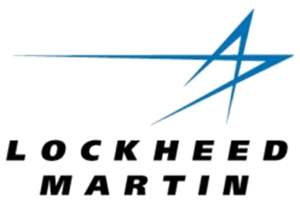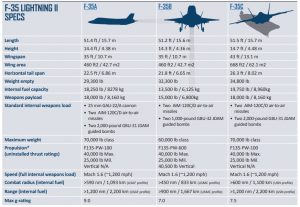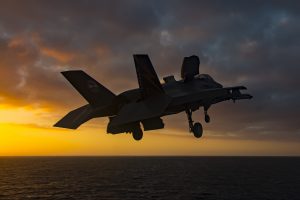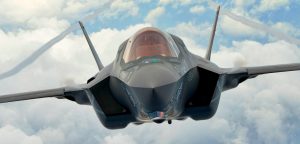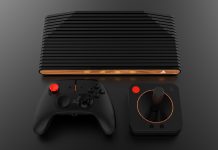In 1997, Lockheed Martin was selected as one of two companies to participate in the Joint Strike Fighter concept demonstration phase. In October 2001, the Lockheed Martin X-35 was chosen as the winner of the competition and teamed with Northrop Grumman and BAE Systems to begin production.
The first production F-35A rolled out of the assembly in Fort Worth, Texas, in February of 2006. Later that year, the stealthy F-35 Joint Strike Fighter, in development by the United States and eight other countries, was named the “Lightning II,” in homage to two earlier fighters.
In December of 2006, the F-35 completed its first flight. Over the next few years, flight and ground test articles of all three variants rolled off the production line and began collecting test points. The first production F-35 conducted its first flight in February of 2011 with deliveries of the aircraft beginning that very same year.
In 2012, the F-35 ramped up with 30 aircraft deliveries and increased testing operations across the United States. The program reached several milestones in weapons separation testing, angle of attack testing, aerial refueling training, and surpassed more than 5,000 flight hours with more than 2,100 recorded flights in that year.
The supersonic, multi-role F-35 represents a quantum leap in air dominance capability with enhanced lethality and survivability in hostile, anti-access airspace environments.
The F-35 combines 5th Generation fighter aircraft characteristics — advanced stealth, integrated avionics, sensor fusion and superior logistics support — with the most powerful and comprehensive integrated sensor package of any fighter aircraft in history. The F-35’s advanced stealth allows pilots to penetrate areas without being detected by radars that legacy fighters cannot evade.
The F-35 is designed with the entire battlespace in mind, bringing new flexibility and capability to the United States and its allies. Reliance on any single capability — electronic attack, stealth, etc. — is not sufficient for success and survivability in the future. Missions traditionally performed by specialized aircraft — air-to-air combat, air-to-ground strikes, electronic attack, intelligence, surveillance and reconnaissance — can now be executed by a squadron of F-35s.
Three Variants, Common Capability
The F-35 family includes three variants:
The F-35A conventional takeoff and landing (CTOL) variant,
the F-35B short takeoff/vertical landing (STOVL) variant, and
the F-35C carrier variant (CV).
The three F-35 variants have similar performance characteristics, and are mainly distinguished by their different basing requirements. As a result, the F-35B and F-35C variants have unique ways to take off and land.
The variation between models allows military forces to achieve service-specific mission capability, while still taking advantage the economies of scale that result from the parts and processes that are common to all three variants. All three variants are supersonic, low observable stealth fighters that all have the same advanced avionics required to execute multirole missions and the support of the F-35 sustainment technologies.
F-35A Lightning II
The F-35A conventional takeoff and landing (CTOL) variant is designed to operate from conventional runways, and is the only version to carry an internal cannon. The F-35A will be the most prevalent variant of the F-35. The U.S. Air Force as well as the majority of our allied air forces and Foreign Military Sales (FMS) nations will operate the F-35A, replacing their 3rd and 4th generation aircraft.
Virtually undetectable to an enemy that cannot hide, the conventional takeoff and landing (CTOL) F-35A gives the U.S. Air Force and allies the power to dominate the skies – anytime, anywhere. It’s an agile, versatile, high-performance 9g multirole fighter that provides unmatched capability and unprecedented situational awareness.
The F-35A’s advanced sensor package is designed to gather and distribute more information than any fighter in history, giving operators a decisive advantage over all adversaries. Its tremendous processing power, open architecture, sophisticated sensors, information fusion and flexible communication links make the F-35 an indispensable tool in future homeland defense, joint and coalition irregular warfare, and major combat operations.
With conventional takeoff and landing capability, the F-35A is built for traditional air force bases. The F-35A uses the boom method of aerial refueling and is the only variant to have an internal cannon. The U.S. Air Force as well as the majority of our allied air forces will fly the F-35A, making it the most prevalent F-35 variant.
F-35B Lightning II
The F-35B model short takeoff/vertical landing (STOVL) variant is designed to operate from austere, short-field bases and a range of air-capable ships operating near front-line combat zones. The F-35B can also take off and land conventionally from longer runways at major bases.
The F-35B short takeoff/vertical landing (STOVL) variant is the world’s first supersonic STOVL stealth aircraft. It is designed to operate from austere bases and a range of air-capable ships near front-line combat zones. It can also take off and land conventionally from longer runways on major bases. The U.S. Marine Corps’ F-35B aircraft reached initial operational capability (IOC) on July 31, 2015, and as of January 2017, a squadron of F-35Bs is permanently based at MCAS Iwakuni, Japan. The F-35B STOVL operation is made possible through the Rolls-Royce patented shaft-driven LiftFan® propulsion system and an engine that can swivel 90 degrees when in short takeoff/vertical landing mode. Because of the LiftFan®, the STOVL variant has a smaller internal weapon bay and less internal fuel capacity than the F-35A. It uses the probe-and-drogue method of aerial refueling.
F-35B aircraft have been delivered to the U.S. Marines and the UK. U.S. STOVL aircraft are stationed at the first operational F-35B base, Marine Corps Air Station Yuma, Arizona, and Marine Corps Air Station Beaufort, South Carolina, where F-35B training is taking place. The first UK F-35Bs are located at RAF 17 Squadron, Edwards AFB, California, where operational testing is being conducted. The Italian Air Force will also operate the F-35B.
F-35C Lightning II
For the first time in U.S. Naval aviation history, radar-evading stealth capability comes to the carrier deck. The F-35C carrier variant (CV) is the Navy’s first stealth fighter and the world’s only 5th Generation, long-range stealth strike fighter designed and built explicitly for aircraft carrier operations.
Aircraft carriers remain at the forefront of U.S. military power, and the backbone of any carrier strike group is the aircraft it brings to the fight. The 5th Generation F-35C Lightning II is the only fighter that can respond to tomorrow’s threats and preserve the U.S. Navy’s maritime supremacy. Our naval aviators deserve nothing less than the most advanced capabilities to ensure they are able to perform their missions and return home safely. More than 50 years of aircraft carrier-based fighter evolution culminates in the F-35C. Never before has low observable stealth been available at sea. The F-35C carrier variant (CV) is the world’s only 5th Generation, long-range stealth strike fighter designed and built explicitly for carrier operations.The U.S. Navy is the largest customer receiving F-35Cs, with the U.S. Marine Corps also planning to acquire the C variant in addition to the F-35B.
The F-35C combines this unique capability of operating from a carrier deck with the unmatched 5th Generation capabilities of stealth, fused sensors and reliability, making the F-35C the Navy’s future first-day-of-the-war strike fighter.
The Navy and Marines require an aircraft capable of overcoming a variety of threats — surface-to-air missiles, air-to-air missiles and tactical aircraft. By leveraging this potent combination of stealth, advanced jamming and threat system destruction, the F-35C enhances survivability and increases mission success rates.
The F-35C variant has larger wings and more robust landing gear than the other variants, making it suitable for catapult launches and fly-in arrestments aboard naval aircraft carriers. Its wingtips also fold to allow for more room on the carrier’s deck while deployed.
The F-35C also has the greatest internal fuel capacity of the three F-35 variants. The F-35C carries nearly 20,000 pounds of internal fuel for longer range and better persistence than any other fighter in a combat configuration. And, like the F-35B, the F-35C uses probe and drogue refueling. This allows the Navy to operate its carriers a safe distance from the threat while its fighters reach remote targets.
Production Costs
The F-35 Lightning II was designed to be an affordable 5th Generation fighter, taking advantage of economies of scale and commonalities between the three variants. Since the first F-35 was built production costs have dropped approximately 60 percent.
The most recent LRIP 10 contract reflects an average airframe unit cost approximately 8 percent lower than the LRIP 9 contract signed in 2016 and an approximate 62 percent reduction since LRIP 1. LRIP 10 Aircraft Costs (including jet, engine and fee) are:
- 76 F-35As CTOL – $94.3 million (7.3% reduction from Lot 9)
- 12 F-35Bs STOVL – $122.4 million (6.7% reduction from Lot 9)
- 2 F-35Cs CV – $121.2 million (7.9% reduction from Lot 9)
The U.S. Government, Lockheed Martin and the F-35 industrial team continue to collaborate to further reduce F-35 costs for future production lots.
In 2014, the DoD announced an industry-led effort called “Blueprint for Affordability” and expanded the effort in 2016 from a $1.8 billion to a $4 billion savings initiative. The goal of these programs is to drive the cost of an F-35A to less than $85 million in 2019, where it will be equivalent to, or less, than any 4th-generation fighter.
Electronic Attack
Advanced electronic warfare (EW) capabilities enable F-35 pilots to locate and track enemy forces, jam radars and disrupt attacks with unparalleled effectiveness. Advanced avionics give the pilot real-time access to battle space information with 360-degree coverage and an unparalleled ability to dominate the tactical environment. Data collected by sensors on the F-35 will immediately be shared with commanders at sea, in the air or on the ground, providing an instantaneous, high-fidelity view of ongoing operations – making the F-35 a formidable force multiplier while enhancing coalition operations. This system allows F-35 pilots to reach well-defended targets and suppress enemy radars.
Air-to-surface
The F-35’s very low-observable (VLO) stealth allows it to safely enter defended airspace areas without being seen by radars that 4th Generation and earlier legacy fighters cannot evade. The combination of the stealth features, active electronically-scanned array (AESA) radar technology, and the aircraft’s ability to carry its full component of weapons stores and fuel internally allows F-35 pilots to engage ground targets at longer ranges without being detected and tracked, using precision-guided munitions and air-to-air radar-guided missiles to successfully complete air-to-ground missions. In this “clean” configuration, the F-35 will enter the air battlespace first, clearing the way with air dominance for follow-on legacy coalition forces to operate with relative impunity.
Air-toAir
The F-35’s integrated sensors, information and weapons systems give pilots an advantage over potential threat front-line fighter aircraft. Compared to 5th Generation fighters like the F-35 and F-22, legacy aircraft have a larger radar cross-section (RCS), which means they can be more easily detected by enemy radar. In aerial combat, legacy aircraft have relatively equal opportunities to detect and engage one another, while a 5th Generation fighter pilot can see enemy aircraft first and take decisive, lethal action from a stand-off distance. The ability to see and not be seen is redefining previous generation air-to-air tactics.
Intelligence, Surveillance and Reconnaissance (ISR)
Drawing on the advantage of stealth, advanced sensors, and data fusion providing enhanced pilot situational awareness, F-35 pilots can fly critical ISR missions with more sophisticated data capture than any previous fighter aircraft.
The F-35 has the most powerful and comprehensive integrated sensor package of any fighter aircraft in history, giving pilots 360-degree access to “real-time” battlefield information. The information gathered by F-35 sensors can be securely shared with commanders at sea, in the air or on the ground, providing a comprehensive view of ongoing operations. Much of the F-35’s electronic warfare and ISR capabilities are made possible by a core processor that can perform more than 400 billion operations per second. This core processor collects data from the classified electronic warfare suite, developed by BAE Systems, to identify enemy radar and electronic warfare emissions and, as happens with the eight sensor Electro-Optical Targeting System (EOTS) providing the pilot 360-degree coverage, recommending which target to attack and whether he or she should use either kinetic or electronic means to counter or negate the threat.
Unparalleled Stealth
The F-35’s stealth capabilities are unprecedented in tactical fighter aviation. An integrated airframe design, advanced materials and other features make the F-35 virtually undetectable to enemy radar. Extensive analysis and flight test of the survivability of the F-35 with its combination of stealth, advanced sensors, data fusion, sophisticated countermeasures, and electronic attack demonstrate conclusively its superior advantages over legacy aircraft.
Interoperability
When it comes to having a ‘quarterback’ for the coalition joint strike force, the inter-operable F-35 is clearly the aircraft for the leadership role. The F-35 is designed to share everything it can see with other aircraft and operation centers to expand situational awareness across the entire network of aircraft. F-35s can support legacy aircraft, as well as other F-35s, to achieve mission success and survivability using a combination of stealth, electronic attack, information sharing, and other measures.
Full Mission Systems Coverage
The term “mission systems” refers to the avionics, integrated electronic sensors, displays and communications systems that collect and share data with the pilot and other friendly aircraft, at sea and on the ground. The F-35 has the most robust communications suite of any fighter aircraft built, to date. Components include the AESA radar, EOTS targeting system, Distributed Aperture System (DAS), Helmet Mounted Display (HMD), and the Communications, Navigation and Identification (CNI) Avionics.
_______________________________________
Photo credit: Lockheed Martin photo by Dane Wiedmann, Andy Wolfe, Lance Cpl. Roderick Jacquote, Chad Bellay
Research to Action © 2018 Time Network (Canada)







